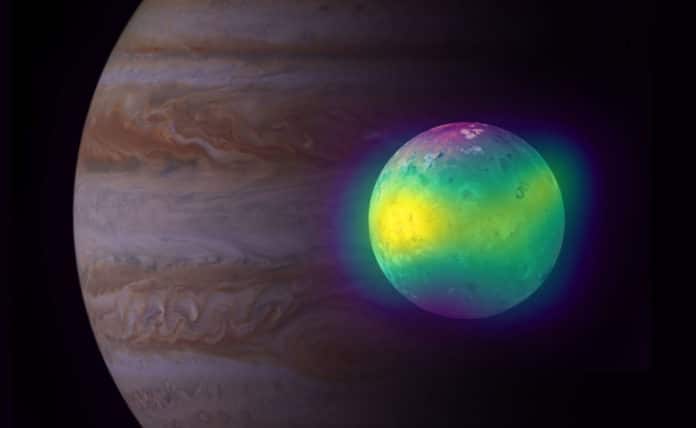Jupiter’s moon Io is unique amongst bodies in our Solar System. The very thin atmosphere is primarily sulfur dioxide, which is sometimes used to preserve dried food on Earth.
Io almost certainly could not support life as we know it. Io is only slightly larger than Earth’s moon and about one-quarter the diameter of Earth itself.
The moon Io is the most volcanically active world in the solar system. Io even has lakes of molten silicate lava on its surface. The volcanoes are, at times, so powerful that they are seen with large telescopes on Earth.
Io has an atmosphere that can teach us about Io’s volcanic activity and provide us a window into the exotic moon’s interior and what is happening below its colorful crust.
New radio images from the Atacama Large Millimeter/submillimeter Array (ALMA) show for the first time the direct effect of volcanic activity on the atmosphere of Jupiter‘s moon Io.
Because of ALMA’s exquisite resolution and sensitivity, astronomers could see the plumes of sulfur dioxide (SO2) and sulfur monoxide (SO) rise from the volcanoes. Using snapshots, astronomers calculated that active volcanoes directly produce 30-50 percent of Io’s atmosphere.
Credit: ALMA (ESO/NAOJ/NRAO), I. de Pater et al.; NRAO/AUI NSF, S. Dagnello; NASA
The images also showed a third gas coming out of volcanoes: potassium chloride (KCl).
Statia Luszcz-Cook from Columbia University, New York, said, “We see KCl in volcanic regions where we do not see SO2 or SO. This is strong evidence that the magma reservoirs are different under different volcanoes.”
Io is volcanically active due to a process called tidal heating. Io orbits Jupiter in an orbit that is not quite circular. The gravitational pull of Jupiter’s other moons Europa and Ganymede causes tremendous amounts of internal friction and heat, giving rise to volcanoes.
Luszcz-Cook said, “By studying Io’s atmosphere and volcanic activity, we learn more about not only the volcanoes themselves but also the tidal heating process and Io’s interior.”
In the future, scientists are planning to study the temperature in Io’s lower atmosphere using ALMA.
The National Radio Astronomy Observatory is a National Science Foundation facility, operated under cooperative agreement by Associated Universities, Inc.
Imke de Pater and Statia Luszcz-Cook worked with Patricio Rojo of the Universidad de Chile, Erin Redwing of the University of California, Berkeley, Katherine de Kleer of the California Institute of Technology (Caltech), and Arielle Moullet of SOFIA/USRA in California.
Journal Reference:
- Imke de Pater, Statia Luszcz-Cook, Patricio Rojo, Erin Redwing, Katherine de Kleer, Arielle Moullet. ALMA Observations of Io Going into and Coming out of Eclipse. Planetary Science Journal, 2020. arXiv:2009.07729
